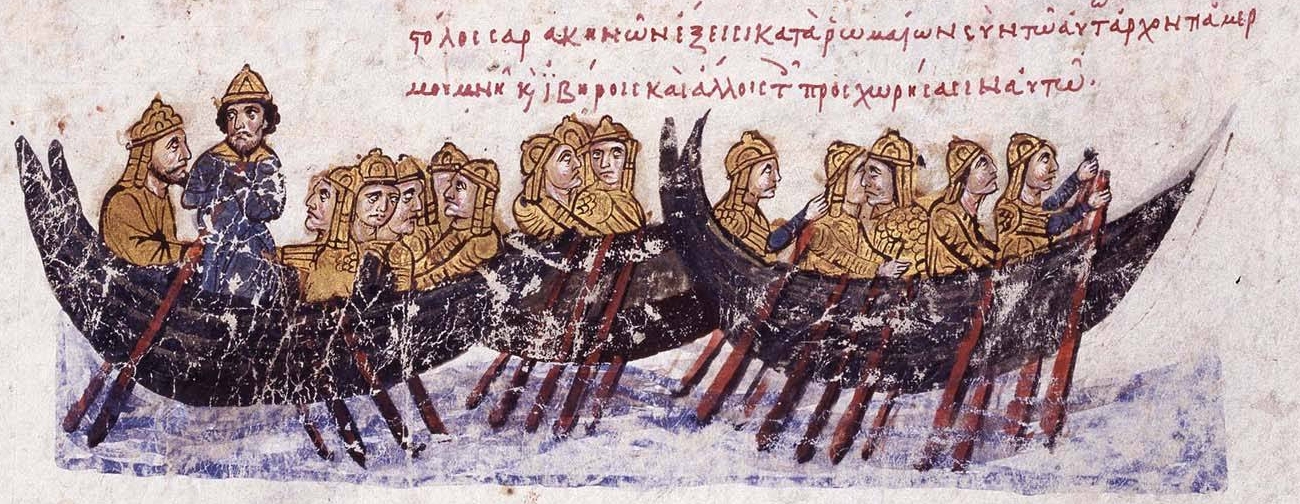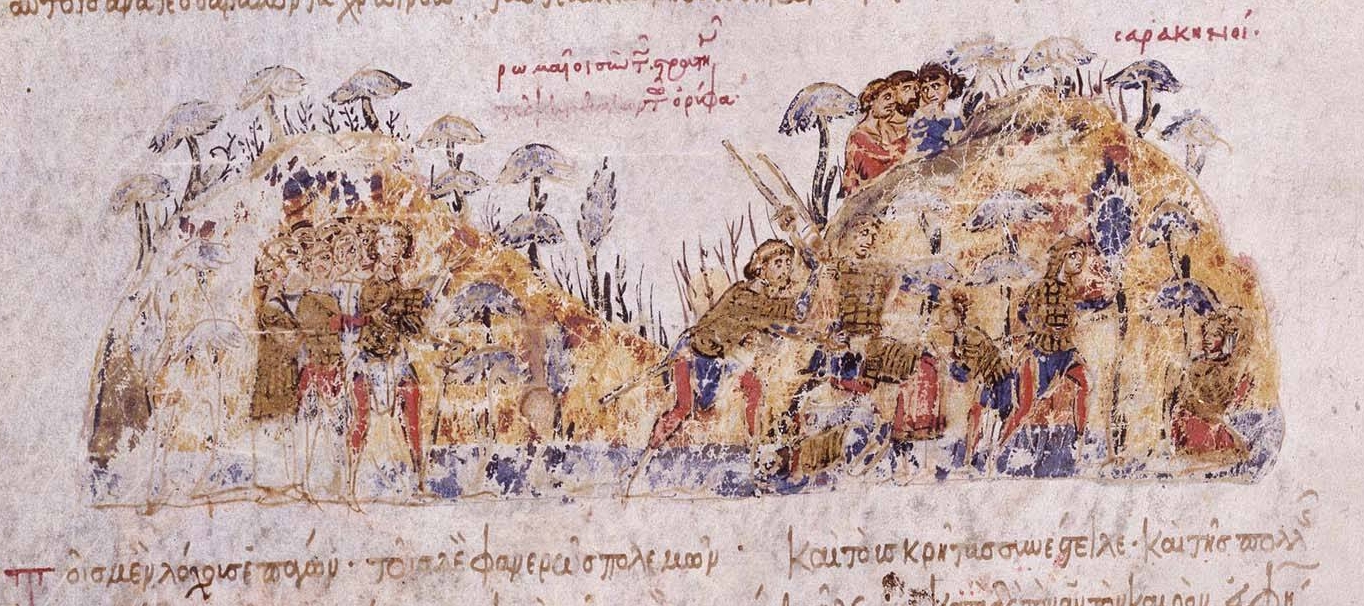Abu Hafs Umar Ibn Shuayb Al-Iqritishi on:
[Wikipedia]
[Google]
[Amazon]
 Abu Hafs Umar ibn Hafs ibn Shuayb ibn Isa al-Balluti (died 855),, in Greek sources , ''Apochaps s'). commonly known as Umar I of Crete, was the leader of a group of
Abu Hafs Umar ibn Hafs ibn Shuayb ibn Isa al-Balluti (died 855),, in Greek sources , ''Apochaps s'). commonly known as Umar I of Crete, was the leader of a group of

 At some point in the second half of the reign of Byzantine Emperor
At some point in the second half of the reign of Byzantine Emperor

 Abu Hafs was responsible for the construction of Chandax, to where the Andalusis transferred the capital from the inland site of
Abu Hafs was responsible for the construction of Chandax, to where the Andalusis transferred the capital from the inland site of
 Abu Hafs Umar ibn Hafs ibn Shuayb ibn Isa al-Balluti (died 855),, in Greek sources , ''Apochaps s'). commonly known as Umar I of Crete, was the leader of a group of
Abu Hafs Umar ibn Hafs ibn Shuayb ibn Isa al-Balluti (died 855),, in Greek sources , ''Apochaps s'). commonly known as Umar I of Crete, was the leader of a group of Andalusi The Arabic '' nisbah'' (attributive title) Al-Andalusi denotes an origin from Al-Andalus. Al-Andalusi may refer to:
* Abu Hayyan al-Gharnati
* Ibn Hazm
* Ibn Juzayy
* Ibn 'Atiyya
* Said Al-Andalusi
* Yaʿīsh ibn Ibrāhīm al-Umawī
See also
* A ...
refugees who seized control of Alexandria and, after being expelled from the city by the Abbasids
The Abbasid Caliphate ( or ; ar, الْخِلَافَةُ الْعَبَّاسِيَّة, ') was the third caliphate to succeed the Islamic prophet Muhammad. It was founded by a dynasty descended from Muhammad's uncle, Abbas ibn Abdul-Muttalib ...
, conquered the Byzantine island of Crete, becoming the first emir of Crete.
Origins
The Byzantine and Arabic sources agree that Abu Hafs was the leader of a group of refugees from al-Andalus, who landed on the island of Crete and conquered it. Traditionally these Andalusis have been described as the survivors of against the emir al-Hakam I of Córdoba in 818. In the aftermath of its suppression, the citizens of the Córdoban suburb of al-Rabad were exiled ''en masse''. Some settled inFez
Fez most often refers to:
* Fez (hat), a type of felt hat commonly worn in the Ottoman Empire
* Fez, Morocco (or Fes), the second largest city of Morocco
Fez or FEZ may also refer to:
Media
* ''Fez'' (Frank Stella), a 1964 painting by the moder ...
in Morocco, but others, numbering over 10,000, took to piracy, probably joined by other Andalusis, landed in Alexandria and took control of the city until 827, when they were besieged and expelled by the Abbasid general Abdullah ibn Tahir al-Khurasani
Abdallah ibn Tahir ( fa, عبدالله طاهر, ar, عبد الله بن طاهر الخراساني) (ca. 798–844/5) was a military leader and the Tahirid governor of Khurasan from 828 until his death. He is perhaps the most famous of th ...
. As W. Kubiak points out, however, the supposed origin from Córdoba is contradicted by other sources, which record the presence of Andalusi corsairs in Alexandria as early as 798/9, and their takeover is dated to 814; furthermore, Abu Hafs, who is recorded as their leader, came from a locality (, now Los Pedroches) that was far from Córdoba. Furthermore, Ibn Hayyan reports that the initial leader of the refugees was not Abu Hafs, but Muhajir ibn al-Qatil. He is echoed by Ibn Sa'id
Abū al-Ḥasan ʿAlī ibn Mūsā ibn Saʿīd al-Maghribī ( ar, علي بن موسى المغربي بن سعيد) (1213–1286), also known as Ibn Saʿīd al-Andalusī, was an Arab geographer, historian, poet, and the most important collector o ...
, who also adds that a certain Yahya, leader of the '' faqih''s of Córdoba who had joined the exiles of Rabad, was another leader. It thus appears that Abu Hafs may have become the leader of the Andalusis at Alexandria, for it is only here that he is explicitly named as the leader of the ''Rabaḍiyyūn'', the "rebels of Rabad", by Ibn Khaldun
Ibn Khaldun (; ar, أبو زيد عبد الرحمن بن محمد بن خلدون الحضرمي, ; 27 May 1332 – 17 March 1406, 732-808 AH) was an Arab
The Historical Muhammad', Irving M. Zeitlin, (Polity Press, 2007), p. 21; "It is, of ...
and al-Maqqari.
Conquest of Crete

 At some point in the second half of the reign of Byzantine Emperor
At some point in the second half of the reign of Byzantine Emperor Michael II
Michael II ( gr, Μιχαὴλ, , translit=Michaēl; 770–829), called the Amorian ( gr, ὁ ἐξ Ἀμορίου, ho ex Amoríou) and the Stammerer (, ''ho Travlós'' or , ''ho Psellós''), reigned as Byzantine Emperor from 25 December 820 to ...
(), the Andalusis landed on Crete and began its conquest. The exact chronology of the Andalusis' landing in Crete is uncertain. Following the Muslim sources, it is usually dated to 827 or 828, after the Andalusis' expulsion from Alexandria. Byzantine sources however seem to contradict this, placing their landing soon after the suppression of the large revolt of Thomas the Slav (821–823), which weakened Byzantine naval defences. Further considerations regarding the number and chronology of the Byzantine campaigns launched against the invaders and prosopographical questions of the Byzantine generals that headed them have led other scholars like Vassilios Christides and Christos Makrypoulias to propose an earlier date, . Christides also suggests that Abu Hafs may have landed on the island in 824/25, on his way to Alexandria, and only returned to conquer the island in 825/26, thus explaining the discrepancy of the sources.
Under the terms of their agreement with Ibn Tahir, the Andalusis and their families left Alexandria in 40 ships. Historian Warren Treadgold estimates them at some 12,000 people, of whom about 3,000 would be fighting men. According to Byzantine historians, the Andalusis were already familiar with Crete, having raided it in the past. The same sources also claim that the Muslim landing was initially intended as a raid, and was transformed into a bid for conquest when Abu Hafs himself set fire to their ships. However, as the Andalusi exiles had brought their families along, this is probably later invention. The Andalusis' landing-place is also unknown; some scholars think that it was at the north coast, at Suda Bay or near where their main city and fortress, Chandax ( ar, ربض الخندق, rabḍ al-kḫandaq, Castle of the Moat, modern Heraklion), was later built, but others think that they most likely landed on the south coast of the island and then moved to the more densely populated interior and the northern coast.
Establishment of the emirate and campaigns against Byzantium

 Abu Hafs was responsible for the construction of Chandax, to where the Andalusis transferred the capital from the inland site of
Abu Hafs was responsible for the construction of Chandax, to where the Andalusis transferred the capital from the inland site of Gortyn
Gortyn, Gortys or Gortyna ( el, Γόρτυν, , or , ) is a municipality, and an archaeological site, on the Mediterranean island of Crete away from the island's capital, Heraklion. The seat of the municipality is the village Agioi Deka. Gortyn ...
, consolidating Muslim rule over the island, and repelling the first, hastily assembled, Byzantine attempts to recover the island under the generals Photeinos and Krateros. He recognized the suzerainty of the Abbasid Caliphate, but ruled as a ''de facto'' independent prince.
The Andalusis also occupied several of the Cyclades during these early years. Michael II's admiral Ooryphas managed to evict the Arabs from the Aegean islands, but failed to retake Crete. The overtures of Theophilos () to Abd ar-Rahman II
Abd ar-Rahman II () (792–852) was the fourth ''Umayyad'' Emir of Córdoba in al-Andalus from 822 until his death. A vigorous and effective frontier warrior, he was also well known as a patron of the arts.
Abd ar-Rahman was born in Toledo, Spai ...
of Córdoba, proposing a joint action against the Andalusi exiles, came to nothing, and in October 829, the Andalusis destroyed an imperial fleet off Thasos, undoing much of the work of Ooryphas and opening the Aegean and its coasts to pillage. Later the Andalusis attacked Euboea (), Lesbos (837), and the coasts of the Thracesian Theme, where they destroyed the monastic centre of Mount Latros. They were heavily defeated, however, by the local ''strategos
''Strategos'', plural ''strategoi'', Linguistic Latinisation, Latinized ''strategus'', ( el, στρατηγός, pl. στρατηγοί; Doric Greek: στραταγός, ''stratagos''; meaning "army leader") is used in Greek language, Greek to ...
'', Constantine Kontomytes
Constantine Kontomytes or Contomytes ( el, , ) was a Byzantine general and nobleman.
Biography
As the governor ('' strategos'') of the Thracesian Theme, Constantine Kontomytes inflicted a severe defeat on the Cretan Saracens in 841, when they r ...
.
After the death of Theophilos in 842, another expedition to recover Crete was launched under the personal leadership of the powerful '' logothetes'' and regent Theoktistos. Although it succeeded in occupying much of the island, Theoktistos had to abandon the army due to political intrigues in Constantinople, and the troops left behind were slaughtered by the Arabs.
From numismatic
Numismatics is the study or collection of currency, including coins, tokens, paper money, medals and related objects.
Specialists, known as numismatists, are often characterized as students or collectors of coins, but the discipline also includ ...
evidence, it appears that Abu Hafs died in and was succeeded by his son, Shu'ayb
Shuaib, Shoaib, Shuayb or Shuʿayb ( ar, شعيب, ; meaning: "who shows the right path") is an ancient Midianite ''Nabi'' (Prophet) in Islam, and the most revered prophet in the Druze faith. Shuayb is traditionally identified with the Biblical ...
.
Notes
References
Sources
* * * * * * * * {{DEFAULTSORT:Abu Hafs 850s deaths 9th-century monarchs in Europe 9th-century people from al-Andalus Medieval Alexandria Emirs of Crete Medieval pirates Year of birth unknown Year of death uncertain Exiles from al-Andalus